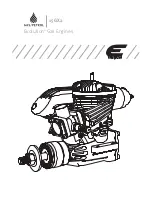
10
Engine Break-in
Your new engine needs to be broken-in to ensure a long life of all the components. This engine
features a piston ring design, which requires a specific break-in procedure to ensure a tight seal
between the piston ring and liner. For this to be accomplished, this process requires repeated
heating and cooling cycles, and must be done at a needle setting that is slightly rich of peak to
ensure the ring expands and contracts. The ring needs to “grow” into the liner for it to develop a
good seal.
Breaking in the piston ring and liner by running it too rich does not provide the necessary parts
growth to accomplish the needed piston ring and liner fitting. However, using too lean of a
setting will cause the ring to become damaged by overheating. Please follow the steps below to
ensure a successful experience.
Important considerations during break-in
• Perform the break-in process with the engine
mounted on your airplane. There is no need
to bench-run the engine prior to mounting it
on your airplane.
• Use the suggested break-in prop to begin
your break-in process. This provides a light
load and high rpm that, when matched with
the heat of the engine, will break in the
engine properly.
• Use the proper recommended fuel with a
20:1 gas to oil ratio for the first gallon of
operation.
The proper break-in flight procedure is to
fly the airplane at full throttle through a
series of figure eight maneuvers (i.e. Cuban
Eight). These maneuvers in particular benefit
the engine because, when climbing, the
additional load on the engine will increase the
temperature and, when diving, the lighter load
and higher rpm will decrease the temperature,
thus providing the heating/cooling cycles
required for the break-in process.
Break-in Process
• first tank of fuel:
Set the high-speed
needle valve at 1.25 turns out and use the
suggested break-in prop. Run the engine on
the ground for its first tank of fuel and DO
NOT go above half throttle. Cycle the throttle
between idle and half throttle every minute.
• Second tank of fuel:
Tune the needle valve
to be slightly rich of the peak RPM at full
throttle without a drop in RPM. Do not run
at full throttle on the ground for more than
30 seconds at a time. Tune the low speed
needle valve for a smooth transition from
idle to mid-range, go back to full throttle
to confirm the main needle valve setting
and then fly. During this flight, be sure to
be conscientious of extended periods of
heating the engine. Be sure to mix-in some
cool-down dives and lower-throttle flying.
• Third tank of fuel:
Fly the engine at high
throttle while performing the recommended
figure eight maneuvers. This will help the
piston ring and cylinder liner to expand and
contract; helping the breaking-in process.
Tune the needle valve to be slightly rich of
the peak RPM as necessary.
• fourth tank of fuel:
Select one of the
recommended propellers for normal
operation and mount it on your engine. Tune
the main needle valve to be slightly rich of
the peak RPM and the low speed needle
valve for a smooth transition from idle to full
throttle and continue to break-in the engine
in flight.
Do not worry about an engine setting being
slightly rich during this process. When set
correctly, the engine will occasionally sound
as if it is misfiring (which it is). During the
climbing maneuvers this should go away and
might return during the diving maneuvers. If it
does not go away during the climbs, land the
airplane and lean the high-speed needle by
1–2 clicks, then take off and fly again. Enjoy
the break-in process—you are doing a lot of
flying.
Continue to fly the airplane through the first
gallon of fuel and then change the fuel mixture
to 32:1 for continued operation.
Содержание 15GX2
Страница 1: ...15GX2 Evolution Gas Engines ...






































